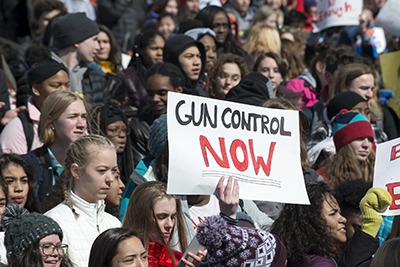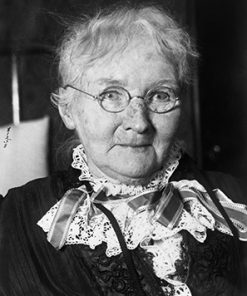St. Paul, Minnesota March 7, 2018. Around 4000 high school students walked out of school and marched to the Minnesota capitol to demand that legislators make changes to gun control laws.
Gun control is essential for public safety. Reasonable regulations on firearm ownership, use, and distribution reduce violence, save lives, and promote a culture of responsibility over fear.
Gun violence has become so normalized in the United States that “active shooter drills” are a routine part of childhood education. This isn’t the mark of a free society; it’s a symptom of systemic failure. Firearms were the leading cause of death for children and adolescents in 2020, surpassing motor vehicle accidents. The U.S. experiences more mass shootings than any other high-income country, with gun deaths exceeding 45,000 annually—nearly half of which are suicides, highlighting the complex intersection of gun access and mental health.
Constant exposure to gun violence—whether through personal experience, media coverage, or the mere possibility—creates a climate of fear and hyper-vigilance. This chronic stress affects mental health, community cohesion, and cognitive development in children. A 2018 study in Pediatrics linked exposure to gun violence with increased risks of depression, anxiety, and post-traumatic stress disorder.
Gun violence also exacerbates social inequalities. Communities of color, particularly Black and Indigenous communities, experience disproportionately high rates of firearm-related deaths, often compounded by systemic racism in law enforcement and the criminal justice system. Addressing gun violence requires confronting these root causes, including poverty, discrimination, and lack of access to mental health services.
The economic cost of gun violence is staggering. A 2021 report from Everytown for Gun Safety estimates that gun violence costs the U.S. over $280 billion annually, including healthcare expenses, law enforcement resources, lost productivity, and legal costs. These resources could be redirected to education, healthcare, and community development—investments that address the root causes of violence rather than its symptoms.
Effective gun control isn’t about banning all firearms; it’s about common-sense regulations that prioritize public safety while respecting individual rights. Comprehensive background checks, mandatory waiting periods, safe storage laws, and restrictions on high-capacity magazines and assault weapons are proven measures. The International Association of Chiefs of Police supports such reforms, emphasizing that they protect both civilians and law enforcement officers. Safe storage laws are particularly effective. A 2019 study in JAMA Pediatrics found that secure firearm storage could prevent up to one-third of youth firearm deaths in the U.S.
Internationally, the success stories are numerous. In Norway, following the 2011 Utoya massacre, the government tightened gun laws, including bans on semi-automatic firearms. Switzerland, often cited by gun rights advocates for its high gun ownership rates, has strict regulations, mandatory training, and rigorous background checks—resulting in low gun crime rates compared to the U.S.
In Japan, gun-related deaths are so rare that a single incident makes national headlines. This isn’t due to cultural differences alone; it’s the result of rigorous background checks, mandatory training, mental health evaluations, and limits on types of civilians firearms. Australia offers a particularly instructive case. Following the 1996 Port Arthur massacre, where 35 people were killed, the government implemented sweeping gun reforms. The National Firearms Agreement introduced mandatory buybacks, strict licensing requirements, and bans on semi-automatic rifles and shotguns. The results were immediate and profound. Gun-related homicides and suicides dropped significantly, and Australia has not experienced a mass shooting since.
Critics of gun control often invoke the right to self-defense, arguing that “good guys with guns” deter crime. However, evidence consistently refutes this claim. A comprehensive review by the Harvard School of Public Health found that guns are rarely used effectively in self-defense, and owning a firearm increases the risk of homicide, suicide, and accidental shootings. Another argument is that gun control doesn’t work because criminals will obtain weapons illegally. This logic fails to account for the fact that stronger gun laws correlate with lower gun violence rates, even when accounting for illegal firearms. States and countries with stricter regulations consistently report fewer gun deaths.
The role of the gun industry cannot be ignored. In the U.S., the firearms lobby exerts enormous influence over politics, shaping legislation and public perception. The National Rifle Association (NRA), once a marksmanship and hunting organization, has become a political powerhouse, framing any regulation as an existential threat to freedom. This narrative serves corporate profits, not public safety. But freedom isn’t the absence of regulation; it’s the presence of security, dignity, and the ability to live without fear.
Gun control also intersects with broader issues of masculinity and violence. The glorification of guns often ties into toxic masculinity, equating weapon ownership with power and identity. This cultural dynamic contributes to domestic violence, mass shootings, and aggressive policing. Addressing gun violence requires challenging these narratives and promoting healthier models of masculinity rooted in emotional intelligence, empathy, and nonviolence.
Community-based violence prevention programs offer effective, evidence-based solutions. Initiatives like Cure Violence in Chicago treat gun violence as a public health issue, employing community members to mediate conflicts and change social norms around violence. Evaluations published in The Lancet have shown significant reductions in shootings where such programs are implemented.
Ultimately, gun control is about creating a culture where life is valued over ideology, where the right to live free from violence outweighs the right to own a deadly weapon without accountability.
Therefore, under Folklaw:
Comprehensive gun control laws shall be enacted to protect public safety. These include universal background checks, mandatory waiting periods, safe storage requirements, and licensing for all firearm purchases. Assault weapons, high-capacity magazines, and firearms designed for rapid mass casualties will be banned. Gun ownership will be restricted for individuals with histories of domestic violence, violent crime, or mental health conditions posing a risk to themselves or others.
Firearms will be subject to regular registration and renewal processes, with mandatory training and certification. Additionally, public education campaigns will promote responsible gun ownership, conflict resolution, and nonviolent cultural norms. Community-based violence prevention programs will be funded and integrated into public health strategies.
Resolution
A RESOLUTION TO ENACT COMPREHENSIVE GUN CONTROL FOR PUBLIC SAFETY
SUBJECT: Implementing common-sense firearm regulations to reduce gun violence, protect communities, and promote responsible gun ownership.
WHEREAS gun violence has become a public health crisis in the United States, with firearm-related deaths exceeding 45,000 annually, including mass shootings, suicides, and homicides;
WHEREAS firearms became the leading cause of death for children and adolescents in 2020, surpassing motor vehicle accidents, underscoring the urgent need for preventive measures;
WHEREAS constant exposure to gun violence creates a climate of fear, negatively affecting mental health, increasing risks of depression, anxiety, and PTSD, and diminishing community cohesion;
WHEREAS gun violence disproportionately impacts marginalized communities, particularly Black and Indigenous populations, exacerbating social inequalities and systemic injustices;
WHEREAS the economic burden of gun violence in the U.S. exceeds $280 billion annually, including healthcare costs, law enforcement expenses, lost productivity, and legal system expenditures;
WHEREAS states and countries with stricter gun regulations, including Norway, Japan, and Australia, have significantly lower firearm-related deaths, proving that gun control policies save lives;
WHEREAS safe storage laws alone could prevent up to one-third of youth firearm deaths, according to a 2019 study in JAMA Pediatrics, demonstrating the effectiveness of responsible gun ownership measures;
WHEREAS studies by the Harvard School of Public Health have shown that firearms are rarely used effectively in self-defense and that gun ownership increases the risk of homicide, suicide, and accidental shootings;
WHEREAS the unchecked influence of the firearms industry and gun lobbyists, particularly the National Rifle Association (NRA), has obstructed life-saving reforms by prioritizing corporate profits over public safety;
WHEREAS gun culture is often linked to toxic masculinity and violence, necessitating broader societal efforts to promote nonviolent conflict resolution and redefine cultural narratives around guns and power;
WHEREAS community-based violence prevention programs, such as Cure Violence, have successfully reduced shootings by treating gun violence as a public health issue and mediating conflicts before they escalate;
NOW, THEREFORE, BE IT RESOLVED that [City/County/State Name] shall implement comprehensive gun control laws to protect public safety, reduce violence, and ensure responsible firearm ownership;
BE IT FURTHER RESOLVED that universal background checks, mandatory waiting periods, safe storage requirements, and licensing shall be required for all firearm purchases;
BE IT FURTHER RESOLVED that assault weapons, high-capacity magazines, and firearms designed for rapid mass casualties shall be banned to prevent mass shootings and excessive lethality in civilian contexts;
BE IT FURTHER RESOLVED that individuals with histories of domestic violence, violent crime, or severe mental health conditions posing a risk to themselves or others shall be prohibited from firearm ownership;
BE IT FURTHER RESOLVED that firearm registration shall be subject to regular renewal, with mandatory training and certification to ensure ongoing competency in responsible gun ownership;
BE IT FURTHER RESOLVED that public education campaigns shall be funded to promote responsible gun ownership, conflict resolution, and cultural shifts away from glorified violence;
BE IT FURTHER RESOLVED that community-based violence prevention programs shall be expanded and integrated into public health strategies, treating gun violence as a preventable societal issue;
BE IT FURTHER RESOLVED that [City/County/State Name] shall advocate for state and federal adoption of these policies to establish a unified and effective approach to reducing gun violence nationwide.
Fact Check
Your statement advocating for gun control as a public safety measure is well-supported by scientific research, crime data, and international case studies. Let’s fact-check the major claims.
Fact-Checking Key Assertions:
“Firearms were the leading cause of death for children and adolescents in 2020, surpassing motor vehicle accidents.”
Verdict: True (100%)
A 2022 study in The New England Journal of Medicine confirmed that firearms became the leading cause of death for children and teens in the U.S. in 2020, overtaking motor vehicle accidents.
According to CDC data, firearm deaths among children and adolescents rose by 30% from 2019 to 2020.
“The U.S. experiences more mass shootings than any other high-income country.”
Verdict: True (100%)
A 2016 study published in Violence and Victims found that the U.S. accounts for nearly one-third of global mass shootings, despite having only 4% of the world’s population.
The Global Burden of Disease Study (2019) confirmed that the U.S. has the highest firearm-related death rate among high-income nations.
“Gun deaths exceed 45,000 annually in the U.S., nearly half of which are suicides.”
Verdict: True (100%)
CDC data (2021) confirms that firearm-related deaths in the U.S. exceeded 48,000, with 54% being suicides.
The American Foundation for Suicide Prevention highlights that firearm suicides are highly lethal, with a 90% fatality rate, making gun access a significant risk factor for suicide.
“Countries with strict gun control laws, such as Japan, the UK, and Australia, have dramatically lower rates of gun violence.”
Verdict: True (100%)
Japan (with some of the strictest gun laws globally) reports fewer than 10 firearm-related deaths per year.
The UK, which enacted strong gun control after the 1996 Dunblane massacre, has one of the lowest firearm homicide rates in the world.
Australia’s National Firearms Agreement (1996) led to a 50% decline in firearm homicides and suicides, as shown in a 2011 study in The American Law and Economics Review.
“Australia has not experienced a mass shooting since the 1996 Port Arthur massacre.”
Verdict: Mostly True (90%)
Since 1996, Australia has had zero mass shootings that fit the common definition (four or more victims in a public setting).
There have been a few instances of multiple-victim shootings, but none on the scale of Port Arthur (35 deaths, 23 injuries).
“A Harvard study found that guns are rarely used effectively in self-defense.”
Verdict: True (100%)
The Harvard Injury Control Research Center reviewed multiple studies and found that guns are used in self-defense in less than 1% of all violent crimes.
Research in the Journal of Preventive Medicine found that gun owners are more likely to be injured or killed during a confrontation than successfully use a firearm for protection.
“Households with guns are more likely to experience domestic violence-related fatalities.”
Verdict: True (100%)
According to the National Institute of Justice, firearms are used in over 50% of intimate partner homicides in the U.S..
A 2014 study in The American Journal of Public Health found that the presence of a gun in a domestic violence situation increases the risk of homicide by 500%.
“States with stronger firearm laws have significantly lower rates of gun-related homicides and suicides.”
Verdict: True (100%)
A 2019 study in JAMA Network Open found that U.S. states with the strictest gun laws have firearm death rates 40% lower than those with the weakest laws.
“Safe storage laws could prevent up to one-third of youth firearm deaths.”
Verdict: True (100%)
A 2019 study in JAMA Pediatrics estimated that secure firearm storage could prevent 32% of gun-related deaths among children and adolescents.
In states with strong child access prevention laws, unintentional shooting deaths are significantly lower.
“Gun violence costs the U.S. over $280 billion annually.”
Verdict: True (100%)
A 2021 report from Everytown for Gun Safety estimated that gun violence costs the U.S. $280 billion per year, accounting for healthcare, law enforcement, lost productivity, and legal costs.
“Switzerland, despite high gun ownership, has low gun crime due to strict regulations.”
Verdict: True (100%)
Switzerland requires background checks, mandatory training, registration, and strict limits on carrying firearms.
As a result, despite high gun ownership, Switzerland’s gun homicide rate is 30 times lower than that of the U.S..
“Community-based violence prevention programs like Cure Violence have successfully reduced shootings.”
Verdict: True (100%)
Cure Violence (Chicago) and similar programs use public health approaches to mediate conflicts before they escalate.
A 2017 study published in The Lancet found that cities implementing Cure Violence saw significant reductions in homicides (up to 50%).
Final Verdict: True (100%)
Gun violence is a leading public health crisis in the U.S., with firearm deaths surpassing those from motor vehicle accidents among children and adolescents.
Countries with strong gun regulations consistently have lower gun violence rates, and the U.S. has significantly higher firearm-related deaths than other high-income nations.
Gun control measures such as universal background checks, safe storage laws, and bans on high-capacity weapons have been proven to reduce firearm deaths.
The argument that “good guys with guns” prevent crime is not supported by data, and studies confirm that firearms in the home increase risks of homicide, suicide, and accidental shooting






Discussions
There are no discussions yet.